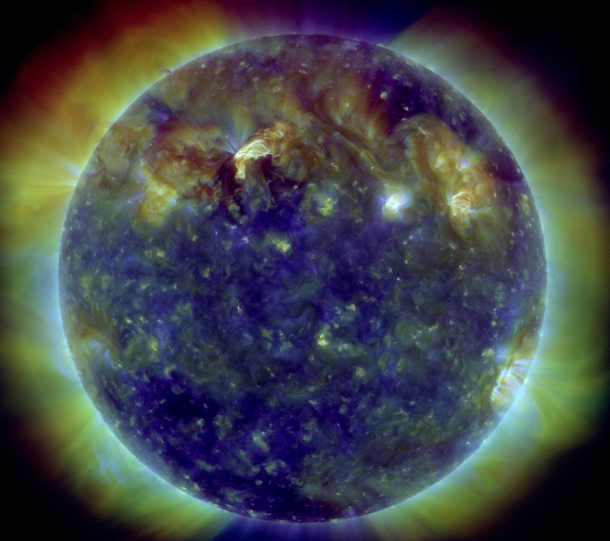Space weather: How solar eruptions could be bad news for gadgets

Network down? It's the Sun what done it...
It's dawn on Friday 2 September 1859 and the sky above the Bahamas is pulsing with red and green light, bright enough to read a newspaper by.
Electricity surges through telegraph cables in Europe and the US, shocking operators who are sending messages and causing their equipment to burst into flames.
The cause of this mayhem just over 150 years ago? None other than the Sun, which hours earlier had belched out a plume of charged particles that streamed across space before smashing into the magnetic shield that surrounds Earth, generating a maelstrom of magnetic fields and electric currents.
Fortunately, in the intervening decades, the Earth has escaped being pummelled by another solar eruption of this magnitude, with a blast of this size only likely to strike our planet once every 500 years.
Still, predicting the weather in space over the long term is an even more inexact science than terrestrial weather forecasting - and if such an event were to take place today scientists believe it could wreak havoc upon the electronic infrastructure that underpins the modern world.
The potential damage that a similar-sized event could cause to power stations and the hundreds of satellites in orbit has been estimated at a total of more than $100bn, notwithstanding the financial losses that worldwide economies would suffer as a result of power and communications blackouts.

The suface of the Sun as captured by the Nasa Solar Dynamics Observatory satellite
(Photo credit: Nasa)
Dr Rami Qahwaji, researcher at the Space Weather Research unit at the University of Bradford, told silicon.com: "The risk comes not only from the damage that is done to power stations or satellites. If you are talking about a city like New York or London and you had to switch off the power stations, the economic impact could be huge.
"If the FTSE wasn't working first thing on a Monday morning, imagine the number of people who would be affected - you'd maybe caused something like £10bn-worth of damage to the economy."
You don't have to look far back in history to see how solar storms can disrupt modern infrastructure: in 1989, a solar eruption triggered a nine-hour black out throughout most of the Canadian state of Quebec, after the resulting power surge tripped circuit breakers at a power station. In 1998, a solar flare shorted components on a satellite operated by PanAmSat, causing problems for several major paging companies. In 2005, there was a 15 minute period where GPS navigation devices intermittently lost connection to the geostationary satellites they rely on to work, because of interference from a solar flare.
Figuring out when the Earth might next be hit by a solar storm on the scale of the 1859 event is a bit more tricky, but the Sun is about to enter a turbulent period of activity...
The frequency with which solar flares burst from the Sun rises and falls according to an 11-year cycle, with 2012 expected to be the next point at which flare activity will peak.
"As you go towards the solar maximum you are more likely to have major eruptions, and we are heading towards the solar maximum in 2012," Qahwaji said.
The average solar flare - basically a burst of radiation from the Sun - rarely causes harm to satellites.
But the main danger to electronics comes from Coronal Mass Ejections (CMEs), eruptions of billions of tons of solar plasma travelling at up to 2,500km a second, capable of generating major magnetic storms in the Earth's magnetic shield, which in turn generates the surges of electricity that damage electronic components.
Communications can also be disrupted as magnetic storms triggered by CMEs affect the ionosphere, the part of the upper atmosphere that is used to bounce radio signals off for long range communication.
Fortunately, Qahwaji said, there are a number of circumstance that need to be fulfilled before we witness effects as severe as that of the 1859 eruption.
"In 1859 there was a perfect alignment of the Sun and Earth and it was a massive event," he said.
"In order to have the perfect storm what you need to have is a very powerful eruption on the Sun, and for the Sun to be facing in such a way that that eruption is directed towards the centre of Earth," he continued, adding that this configuration was made less likely by the fact that both the Earth and the Sun are permanently rotating.
The human race is also not defenceless against these eruptions: Nasa and the European Space Agency have space weather prediction centres that gather data from satellite cameras and sensors trained on the surface of the Sun, watching for Sun spots and the intense magnetic activity that foreshadow an eruption on its surface.
Given enough warning from these space weather centres, satellite operators can place satellite systems into hibernation or temporarily shut down parts of their hardware, protecting them from damage.
Likewise power stations and parts of their associated infrastructure can be shut down to avoid power surges triggering circuit breakers or causing damage.
Mankind's ability to predict solar eruptions should be greatly aided by the Solar Dynamics Observatory, a satellite launched by Nasa in February which is capturing super high resolution images of the Sun every 10 seconds.
Despite these protective measures, Qahwaji said that solar activity does pose a genuine threat to modern societies - a fact that has even caught the attention of Hollywood scriptwriters, who have been busy putting the solar apocalypse onto the silver screen.
"There are quite a few movies about this now, such as 2012 and Knowing. Even Hollywood is now starting to pay attention to it," he said.